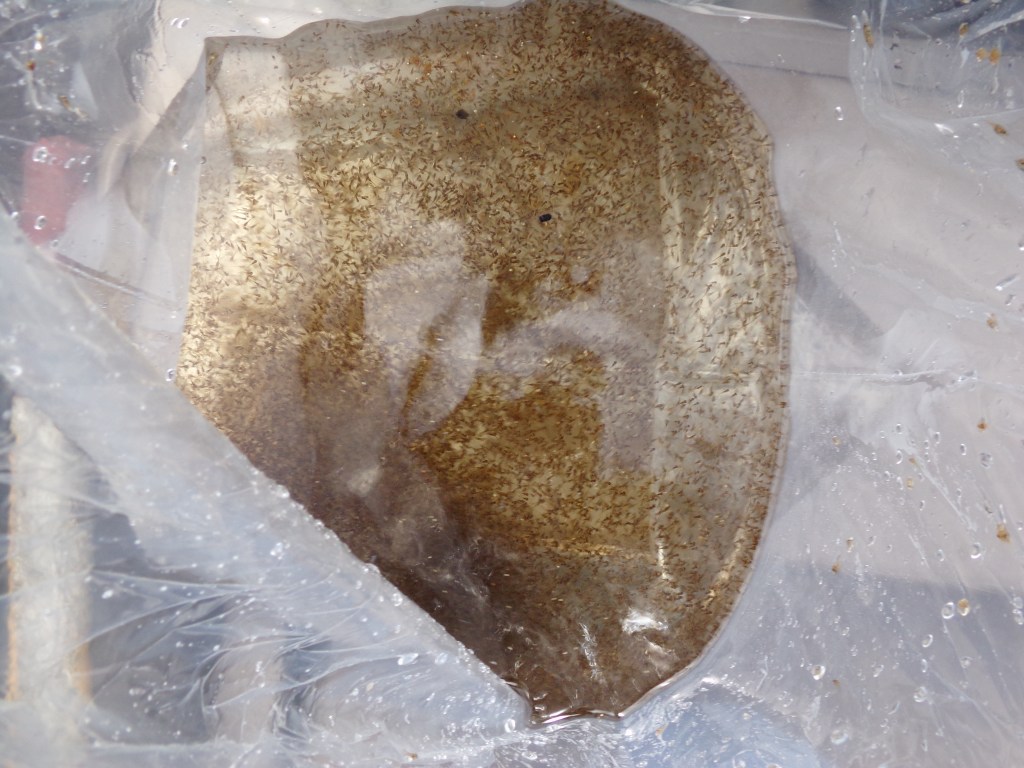Local lake bass population grows as 300,000-plus fry are released
Published 12:00 pm Saturday, April 15, 2023

- The view inside an opened bag containing thousands of Florida bass fry shows the size of the fish stocked Tuesday in Lake Fausse Pointe. The fry were delivered inside 10 bags from the Booker Fowler Fish Hatchery near Woodworth.
LOREAUVILLE – Extra. Extra. Extra. Read all about it.
Lake Fausse Pointe was scheduled to get 150,000 Florida largemouth fry this past week from the Louisiana Department of Wildlife and Fisheries’ Booker Fowler Fish Hatchery. As it turned out, the hatchery was able to send more, many more, of the tiniest bass for release in the local lake.
Brad Launey of Ville Platte, a 16-year veteran inland fisheries biologist with LDWF, was pleased to announce he had 327,000 fry bagged by hatchery personnel and ready for their new home. The bagged bass were swimming comfortably in Styrofoam chests in the bed of an LDWF pickup truck driven from Lafayette to Lake Fausse Pointe State Park by fisheries technician Phillip Allemond of Cecilia.
“They called and said they’ve got extra. I said, ‘Bring me all you can bring.’ We got 327,000. That’s something,” Launey said around midday Tuesday.
Launey, District 6 Inland Fisheries Biologist Manager, and Allemond met the hatchery truck at the LDWF office in Lafayette then drove the precious cargo to the state park nestled on the west side of the West Atchafalaya Basin Protection Levee. From there they loaded the bags into the bottom of a Pro-Drive boat powered by a Pro-Drive.
They launched the boat and motored to two borrow pits along the levee and a canal in the Texaco Field. All three sites are places where the biologist has conducted electrofishing samples to determine the fish population.
At the first stop, a borrow pit with clear water at the back, Launey and Allemond, who has been with the state agency 32 years, loosened tight rubber bands sealing three of the bags, leaned over the side of the boat and gently poured the water and fry into the lake.
Launey chose areas with dense, green cover for the babies to use as a new home.
“Get places like this with a lot of grass and it’ll be better for survival, a lot of places for them to hide,” he said.
Then, talking to the fish, per se, he said, “ ‘Better stay in the grass’.”
The next stop for releasing the fish so tiny they look like particles of dirt moving around in the water was in the Texaco Field. Again, Launey stopped the Pro-Drive and the boat drifted to the edge of a grass mat.
They deposited four bags of fry there in clear water with a healthy green tint.
Launey cranked up the motor against and pointed the bow to another borrow pit. They opened and released the other three bags of baby bass there.
“ ‘Grow my little friend,’” he said as the fish slid out with the water into the borrow pit.
“You’ll be catching some of these in a couple of years,” he said, noting at first they will feed on plankton.
The bass stocking mission, his first of the year in District 6, was complete.
The Florida bass fry were delivered by the state’s largest fish hatchery in the state. Booker Fowler Fish Hatchery was ready and open for spawning bass purposes in 1997. Since then it has produced millions of bass to help state biologists reach management goals across the Sportsman’s Paradise.
LDWF biologists produce and raise Florida bass in the hatchery because so many anglers want a chance to catch a trophy-sized bass. Native bass generally have a slower growth rate than Floridas.
Florida bass fry that headed this way recently more than likely were at least 1 week old, which means they were approximately 7.27 mm long, or 0.286220 inches. It takes 453.49237 grams of fry that size to make 1 pound.
After 45-50 days, a hatchery official has said, surviving fry should be 2-inch long fingerlings that target a forage base larger than plankton in the wild, hunting their own food, much earlier than in a hatchery setting.
The high end survival rate for the Florida bass fry recently released in the lake is 7 percent, according to Texas biologists. Naturally, the survival rate for Florida bass fingerlings, which are larger when they are stocked, is much higher and those fish have a better chance to reach adult size.
Lake Fausse Pointe hasn’t been the recipient of Florida bass fingerlings since 2014, when 80,000 were released by LDWF personnel in District 6.
Hundreds of thousands of Florida bass fry have been stocked in the lake by LDWF in 2019, 2021 and 2022.





